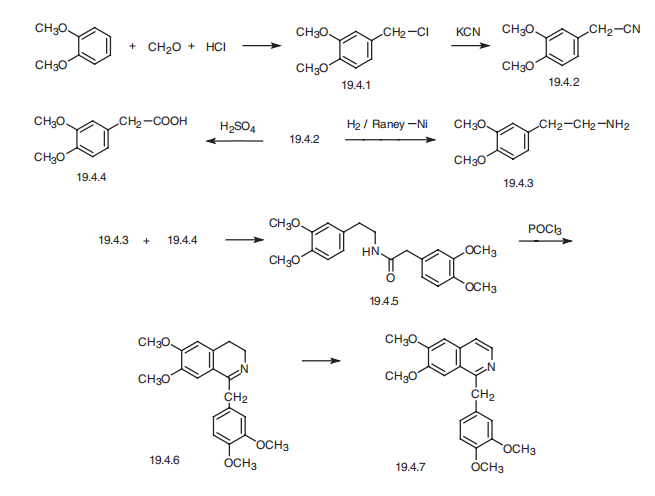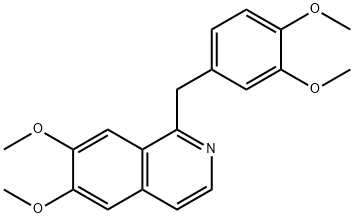ChemicalBook > CAS DataBase List > PAPAVERINE HYDROCHLORIDE
PAPAVERINE HYDROCHLORIDE
PAPAVERINE HYDROCHLORIDE
- CAS No.58-74-2
- Chemical Name:PAPAVERINE HYDROCHLORIDE
- CBNumber:CB4689771
- Molecular Formula:C20H21NO4
- Formula Weight:339.39
- MOL File:58-74-2.mol
PAPAVERINE HYDROCHLORIDE Property
- Melting point 226 °C
- Boiling point 475.36°C (rough estimate)
- Density d420 1.337
- refractive index 1.6250 (estimate)
- solubility H2O: 25 mg/mL
- pka 6.4(at 25℃)
- form powder
- color white
- Water Solubility 37.33mg/L(37.5 ºC)
- Merck 14,7019
- BRN 312930
- EWG's Food Scores 1
- FDA UNII DAA13NKG2Q
- ATC code A03AD01,G04BE02,G04BE52
Safety
- Hazard Codes :Xn
- Risk Statements :22
- Safety Statements :22
- RIDADR :UN 1544 6.1/PG 3
- WGK Germany :1
- RTECS :NW8575000
- F :8
- HazardClass :6.1(a)
- PackingGroup :II
- Hazardous Substances Data :58-74-2(Hazardous Substances Data)
- Toxicity :LD50 orl-rat: 325 mg/kg ARZNAD 20,1338,70
-
NFPA 704:
0 2 0
-
Symbol(GHS)

- Signal wordWarning
- Hazard statements H302
- Precautionary statements P264-P270-P301+P312-P330-P501
PAPAVERINE HYDROCHLORIDE Chemical Properties,Usage,Production
- Chemical Properties White crystalline powder; obtained asorthorhombic prisms from an alcohol–ethermixture; melts at 147°C (296.6°F); sublimesunder vacuum; insoluble in water; soluble inacetone, glacial acetic acid, and benzene.
- Originator Lempav Ty-Med ,Lemmon,US,1975
- Uses Papaverine occurs in opium to the extent of0.8–1.0%, commonly associated with narcotine.It is used as a smooth muscle relaxantand in medicine for its vasodilator action onthe blood vessels in the brain. It is effectiveagainst asthma.
- Uses muscle relaxant (smooth), cerebral vasodilator
- Uses folate metabolic inhibitor, coccidiostat
- Uses opium alkaloid
- Definition ChEBI: A benzylisoquinoline alkaloid that is isoquinoline substituted by methoxy groups at positions 6 and 7 and a 3,4-dimethoxybenzyl group at position 1. It has been isolated from Papaver somniferum.
- Indications Papaverine (Pavabid) is a nonspecific phosphodiesterase inhibitor that increases cAMP and cGMP levels in penile erectile tissue. Papaverine is particularly known as a smooth muscle relaxant and vasodilator. Its principal pharmacological action is as a nonspecific vasodilator of smooth muscles of the arterioles and capillaries. Various vascular beds and smooth muscle respond differently to papaverine administration both in intensity and duration. Papaverine decreases the resistance to arterial inflow and increases the resistance to venous outflow.
- Manufacturing Process To 3.65 g (0.01 mol) of monohydrated adenosine-5'-monophosphoric acid, brought into suspension in a mixture of 45 ml of water and 5 ml of ethanol, are added 339 g (0.01 mol) of papaverine base (melting point, 147°C). The mixture is gently heated until a final temperature of 40°C is reached. The solution obtained is then filtered and the filtrate is concentrated under vacuum. The remaining product quickly crystallizes. After drying to 50°C to constant weight, there are obtained 6.68 g of desired product, in the monohydrated state, as a white crystalline powder, which melts at 140°C and is very soluble in water.
- brand name Pavabid (Hoechst Marion Roussel).
- Therapeutic Function Vasodilator, Platelet aggregation inhibitor
-
Health Hazard
Papaverine is an inhibitor of cyclic nucleotidephosphodiesterase, producing vasodilatoryeffect. The acute toxic effects relative tophenanthrene-type opium alkaloids (e.g.,morphine, heroin) are low and the symptomsare not the same. Papaverine is neither a narcoticnor an addictive substance. Excessivedoses may produce drowsiness, headache,facial flushing, constipation, nausea, vomiting,and liver toxicity.
The LD50 data reported in the literatureshow variation. An oral LD50 value in rats ison the order of 400 mg/kg. - Mechanism of action When administered by intracavernosal injection, papaverine, a weak and nonspecific PDE inhibitor, is thought to cause relaxation of the cavernous smooth muscles and vasodilation of the penile arteries by inhibition of PDE. These effects result in increased arterial blood flow into the corpus cavernosa and in swelling and elongation of the penis. Venous outflow also is reduced, possibly as a result of increased venous resistance.
- Clinical Use Papaverine is highly effective in men with psychogenic and neurogenic ED but less effective in men with vasculogenic ED. Papaverine–phentolamine combinations have been used in self-injection procedures. Papaverine doses may range from 15 to 60 mg. Papaverine treatment in patients with severe arterial or venous incompetence is usually unsuccessful, but autoinjections using low doses sufficient to achieve an erection are safe and efficient.
- Side effects Major side effects associated with papaverine therapy include priapism, corporeal fibrosis, and occasional increases in serum aminotransferases. Intracorporeal scarring may be related to the low pH of the vehicle that is necessary to solubilize papaverine.Attempts to buffer papaverine to render it more suitable for intracavernosal injection have not been entirely satisfactory, and such delivery may still lead to intracorporeal scarring.
- Safety Profile Poison by ingestion, intramuscular, subcutaneous, intradermal, intraperitoneal, and intravenous routes. Human systemic effects: coma, somnolence. Its central nervous system action is about midway between those of morphme and codeine, and large doses do not produce the amount of excitement caused by codeine or the soporific action of morphine. Mutation data reported. A cerebral vasodilator and smooth muscle relaxant. Combustible when exposed to heat or flame. When heated to decomposition it emits toxic fumes of NOx. See also MORPHINE.
-
Synthesis
Papaverine, 1-veratryl-6,7-dimethoxyisoquinolin (19.4.7), is synthesized
from veratrol. Veratrol undergoes chloromethylation, forming 3,4-dimethoxybenzylchloride
(19.4.1). Reacting this with potassium cyanide gives 3,4-dimethoxybenzylcyanide (19.4.2).
The resulting 3,4-dimethoxybenzylcyanide undergoes reduction by hydrogen over Raney
nickel, forming homoveratrylamine (19.4.3). At the same time 3,4-dimethoxybenzylcyanide
(19.4.2) undergoes acidic hydrolysis giving 3,4-dimethoxyphenylacetic acid
(19.4.4). The interaction of the resulting compounds brings to corresponding amide
(19.4.5). The cyclization of this by Bischler¨CNapieralski method, using phosphorous oxychloride,
gives 3,4-dihydropapaverine (19.4.6), which is dehydrated into the desired papverine
when heated in tetraline at high temperatures.

PAPAVERINE HYDROCHLORIDE Preparation Products And Raw materials
Raw materials
Preparation Products
Global(0)Suppliers
58-74-2, PAPAVERINE HYDROCHLORIDERelated Search:
- Elziverine ethaverine Papaverine hydrochloride Dimoxyline PAPAVERINE HYDROCHLORIDE Drotaverin hydrochloride R-tetrahydropapaverine HCl (+/-)-Tetrahydropapaverine R-Tetrahydropapaverine N-acetyl-L-leucinate BOLDINE DIMETHYL ETHER (R)-(+)-Tetrahydropapaverine Tetrahydropapaverine hydrochloride 1-[(3,4-Dimethoxyphenyl)methyl]-3,4-dihydro-6,7-dimethoxyisoquinoline 6,7-DIMETHOXYISOQUINOLINE 1-(2-bromo-4,5-dimethoxybenzyl)-6,7-dimethoxyisoquinoline ethaverine hydrochloride TOSLAB 11931 DIOXYLINEPHOSPHATE
- 中草药成分
- Cell Biology
- Cell Signaling and Neuroscience
- BioChemical
- Phosphodiesterase Inhibitors
- Nucleosides
- Oligonucleotide Synthesis
- Specialty Synthesis
- G Proteins and Cyclic Nucleotides
- Cyclic Nucleotide Metabolism
- Alkaloids
- Isoquinoline Alkaloids
- 盐酸诺卡平水合物杂质A
- 那可汀杂质A
- 罂粟碱,99%
- PAPAVERINE(甄准不供应)
- 罂粟碱(见QP160960)
- 罂粟碱
- 罌粟鹼
- 6,7-二甲氧-1-藜蘆基異喹啉
- 6,7-二甲氧-1-藜基喹啉
- 1-(3,4-二甲氧基苄基)-6,7-二甲氧基异喹啉
- 怕啪非林
- 6,7-二甲氧基-1-藜芦基-异盐酸喹啉
- 6,7-二甲氧基-1-藜芦基-异喹啉
- 6,7,3',4'-四甲氧基-1-苄基
- 1-[(3,4-二甲氧苯基)甲基]-6,7-二甲氧基-异盐酸喹啉
- 1-[(3,4-二甲氧苯基)甲基]-6,7-二甲氧基异喹啉盐酸盐
- 1-[(3,4-二甲氧苯基)甲基]-6,7-二甲氧基-异喹啉
- 1-[(3,4-二甲氧苯基)甲基]-6,7-二甲氧基异喹啉
- 氯水合物罂粟碱
- 氯化罂粟碱嗡
- 单盐酸盐罂粟碱
- 58-74-2
- Demeton Impurity 9
- 1-[(3,4-dimethoxyphenyl)methyl]-6,7-dimethoxyisoquinoline (papaverine)
- 1-(3,4-dimethoxybenzyl)-6,7-dimethoxyisoquinoline (papaverine)
- PAPAVERINE HCL
- PAPAVERINE
- papaverin
- PapaverineQ: What is Papaverine Q: What is the CAS Number of Papaverine Q: What is the storage condition of Papaverine
- NSC 136630
- Papaverine (See QP160960)
- Papaverine Labeled d6
- 6,7-DIMETHOXY-1-VERATRYL-ISOQUINOLINE HYDROCHLORIDE
- 6,7-DIMETHOXY-1-VERATRYLISOQUINOLINE HCL
- 1-(3,4-DIMETHOXY-BENZYL)-6,7-DIMETHOXY-ISOQUINOLINE
- 1-[(3',4'-DIMETHOXYPHENYL)METHYL]-6,7-DIMETHOXYISOQUINOLINE HCL
- Papaveri
- Papanerin-HCl [German]
- Papalease
- Papacon
- isoquinoline, 1-[(3,4-dimethoxyphenyl)methyl]-6,7-dimethox
- 18) META CHLORO BENZALDEHYDE
- Papaverine,99%
- S-M-R
- Robaxapap
- Papaverina
